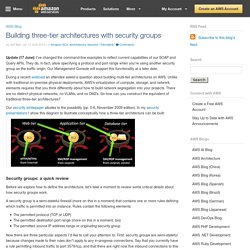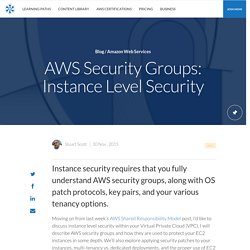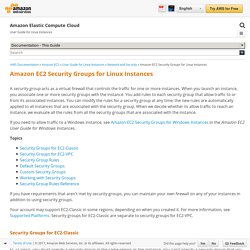

Untitled. Building three-tier architectures with security groups. Update (17 June): I’ve changed the command-line examples to reflect current capabilities of our SOAP and Query APIs.

They do, in fact, allow specifying a protocol and port range when you’re using another security group as the traffic origin. Our Management Console will support this functionality at a later date. During a recent webcast an attendee asked a question about building multi-tier architectures on AWS. Unlike with traditional on-premise physical deployments, AWS’s virtualization of compute, storage, and network elements requires that you think differently about how to build network segregation into your projects.
There are no distinct physical networks, no VLANs, and no DMZs. Our security whitepaper alludes to the possibility (pp. 5-6, November 2009 edition). Security groups: a quick review Before we explore how to define the architecture, let’s take a moment to review some critical details about how security groups work. The second aspect is our terminology for port ranges. AWS Security Groups: Instance Level Security. Moving on from last week’s AWS Shared Responsibility Model post, I’d like to discuss instance level security within your Virtual Private Cloud (VPC).

I will describe AWS security groups and how they are used to protect your EC2 instances in some depth. We’ll also explore applying security patches to your instances, multi-tenancy vs. dedicated deployments, and the proper use of EC2 Key Pairs. From last week’s blog, you will remember that instance level security is your responsibility, and that AWS provides you with the tools you’ll need completely control access to your instances. If you were to adopt only one of those tools as a result of this article, I would suggest that it should be AWS security groups. Security groups are easy to set up, easy to manage, and add a great deal of security to your resources. AWS security groups and cloud security AWS security groups (SGs) are associated with EC2 instances and provide security at the protocol and port access level.
Type. Limits EC2 Key Pairs. Amazon EC2 Security Groups for Linux Instances. A security group acts as a virtual firewall that controls the traffic for one or more instances.

When you launch an instance, you associate one or more security groups with the instance. You add rules to each security group that allow traffic to or from its associated instances. You can modify the rules for a security group at any time; the new rules are automatically applied to all instances that are associated with the security group. When we decide whether to allow traffic to reach an instance, we evaluate all the rules from all the security groups that are associated with the instance.
If you need to allow traffic to a Windows instance, see Amazon EC2 Security Groups for Windows Instances in the Amazon EC2 User Guide for Windows Instances. If you have requirements that aren't met by security groups, you can maintain your own firewall on any of your instances in addition to using security groups. Your account may support EC2-Classic in some regions, depending on when you created it. Security Groups for Your VPC - Amazon Virtual Private Cloud.
A security group acts as a virtual firewall for your instance to control inbound and outbound traffic.

When you launch an instance in a VPC, you can assign the instance to up to five security groups. Security groups act at the instance level, not the subnet level. Therefore, each instance in a subnet in your VPC could be assigned to a different set of security groups. If you don't specify a particular group at launch time, the instance is automatically assigned to the default security group for the VPC. For each security group, you add rules that control the inbound traffic to instances, and a separate set of rules that control the outbound traffic. You might set up network ACLs with rules similar to your security groups in order to add an additional layer of security to your VPC.
Security Group Basics The following are the basic characteristics of security groups for your VPC: Default Security Group for Your VPC Your VPC automatically comes with a default security group. Note.